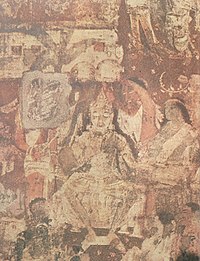List_of_Sri_Lankan_monarchs
The monarchs of Sri Lanka,[N 1] also referred to as the Sinhalese monarchy, were the heads of state and rulers of the Sinhala Kingdoms located in present-day Sri Lanka, from 543 BCE (according to chronicles) until its abolition in 1815 CE.
This article has multiple issues. Please help improve it or discuss these issues on the talk page. (Learn how and when to remove these template messages)
|
The Sinhalese monarchy began with the settlement of North Indian Indo-Aryan speaking immigrants to the island of Sri Lanka. The Landing of Vijaya (as described in the traditional early chronicles of the island, the Dipavamsa and Mahavamsa) recounts the date of the establishment of the first Sinhalese Kingdom in 543 BCE[N 2] when Indian prince Prince Vijaya (543–505 BCE) and 700 of his followers arrived in Sri Lanka, establishing the Kingdom of Tambapanni.[1][2] In Sinhalese mythology, Prince Vijaya and followers are told to be the progenitors of the Sinhalese people. However, according to the story in the Divyavadana, the immigrants were probably not led by a scion of a royal house in India, as told in the romantic legend, but rather may have been groups of adventurous and pioneering merchants exploring new lands.[3] On the other hand, other historians such as G.C. Mendis have suggested that the Vijaya story is a myth and has no historical basis.[4]
The Sinhala Kingdoms comprised the political states of the Sinhalese people and their ancestors; it existed as a series of successive kingdoms known by the city in which the administrative centre of the kingdom was located. These are, in chronological order: the kingdoms of Tambapanni, Upatissa Nuwara, Anuradhapura, Polonnaruwa, Dambadeniya, Gampola, Kotte, Sitawaka and Kandy.[5][6][7][8] The last Sinhala Kingdom came to an end in 1815 with Sri Vikrama Rajasinha of Kandy after generations of European colonial influences and upheaval in the royal court.
During the two millennia of Sinhalese kingdoms, other political entities also existed on the island, including the Jaffna Kingdom,[9] the Vanni chieftaincies and the Portuguese and Dutch colonies.[10] These political entities are considered separate from the Sinhala Kingdoms.[11][12] A separate page lists the monarchs of the Jaffna Kingdom.
During the reign of Devanampiya Tissa (307–267 BCE), Buddhism was introduced to the island by Ashoka of India.[13] By the time of Kithsirimevan (304–332 CE), Sudatta, the subking of Kalinga and Hemamala brought the Tooth Relic of the Buddha to Sri Lanka due to unrest in the country.[14] Kithsirimevan carried it in procession and placed the relic in a mansion named Datadhatughara.[15] He ordered this procession to be held annually, and this is still done as a tradition in the country to this day. The Tooth Relic of the Buddha soon became one of the most sacred objects in the country and a symbol of kingship. The person who was in possession of the Tooth Relic would thereafter be considered the rightful ruler of the country.[16]
The role of the monarch was absolute. The monarch was head of state but would be aided with high level officials and a board of ministers. The monarch was later seen as the supreme ruler throughout the island, even at times when they did not have absolute control over it.[17] However, the earliest inscriptions dating from the 3rd to 2nd century BCE suggest that the island was divided into several regional principalities and chieftaincies until the first war of unification fought by King Dutugamunu.[18] These early kings sought to establish control over the whole island, though in reality this was more of an aspiration. However periods of effective control over the whole island did exist from time to time.[19] The monarch also held judicial power and influence. Judicial customs, traditions and moral principles based on Buddhism were used as the bases of law. The laws and legal measures were proclaimed by the monarch, and were to be followed by the justice administration.[20] However the monarch was the final judge in legal disputes, and all cases against members of the royal family and high dignitaries of the state were judged by them, although this power was to be exercised with care and after consulting with their advisers.[21]
This article is a list of monarchs that have reigned over the nine successive kingdoms of the Sinhalese monarchy.[22][23] It is based on the traditional list of monarchs as recorded in the chronicles of the island, in particular the Mahavamsa and Rajavaliya.[24][25] It is not a list of ethnically Sinhalese monarchs as it contains all rulers of the Sinhalese kingdoms, both Sinhalese and foreign. Each monarch belongs to one of nine royal houses (Vijaya, Lambakanna I, Moriya, Lambakanna II, Vijayabahu, Kalinga, Siri Sanga Bo, Dinajara and Nayaks[N 3]), and follows a tradition of regnal names that span the entirety of the monarchy. For example, Vijayabahu was used 7 times over multiple kingdoms and multiple royal houses over a period of 500 years and there is no overlap of names, Vijayabahu I, II, III, IV, V, VI, VII. The same is true for Aggabodhi, Bhuvanaikabahu, Kassapa, Mahinda, Parakramabahu and others.


